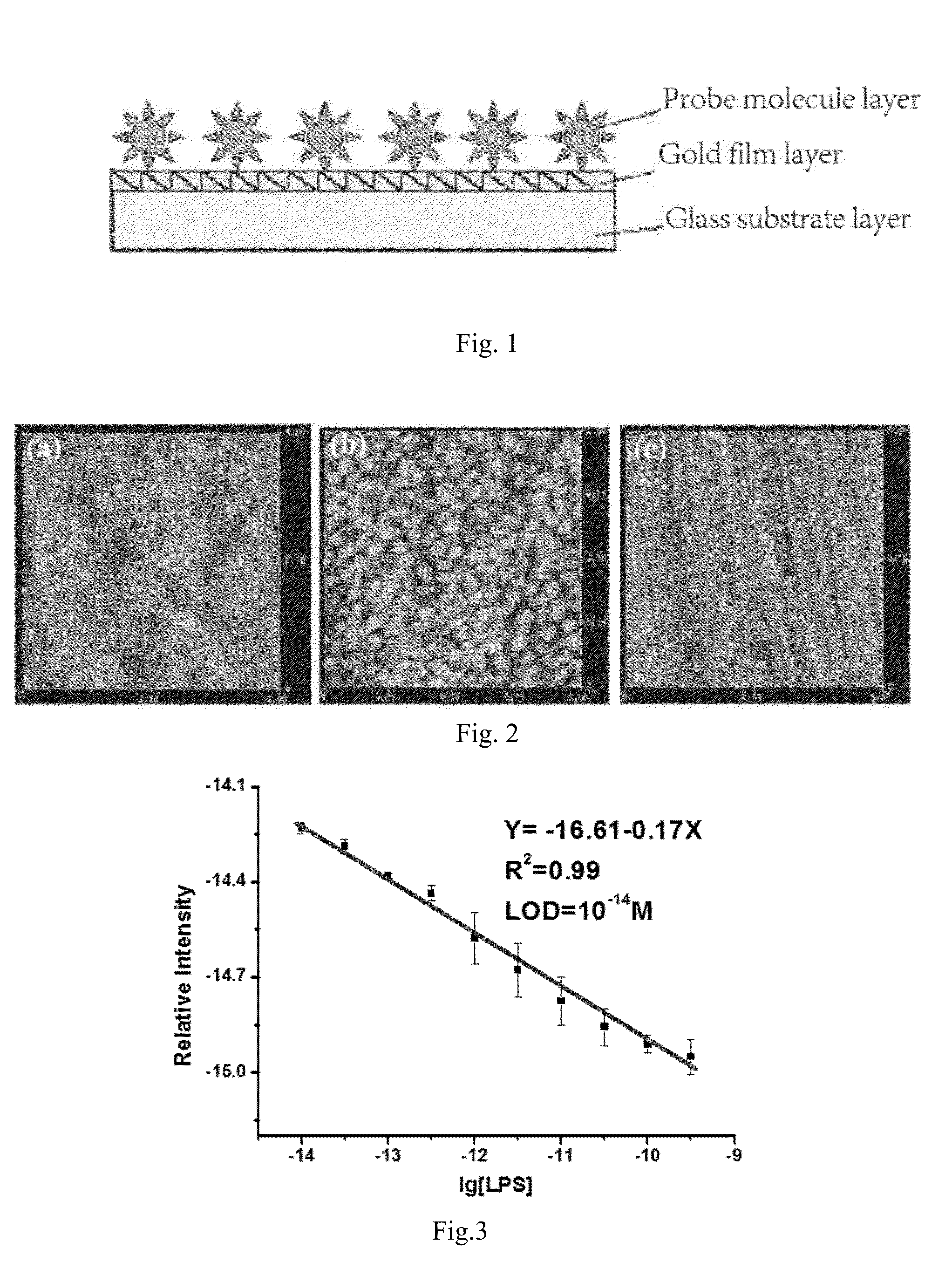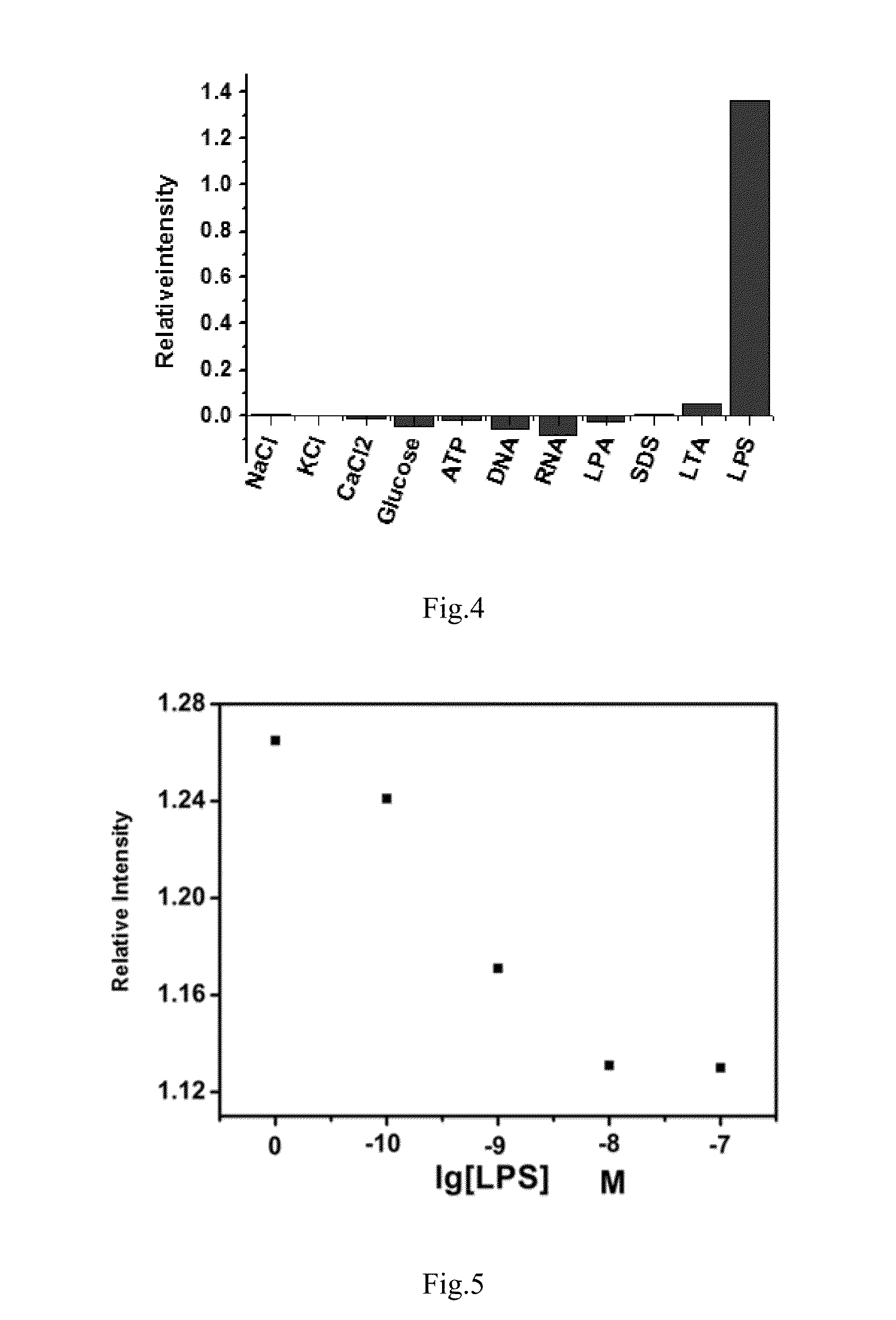Surface plasmon resonance sensor chip, and preparation method and application thereof
- Summary
- Abstract
- Description
- Claims
- Application Information
AI Technical Summary
Benefits of technology
Problems solved by technology
Method used
Image
Examples
embodiment 1
[0066]A surface plasmon resonance sensor chip, comprising a glass substrate layer, a gold film layer and a probe molecule layer; the gold film layer is disposed on the glass substrate layer and the probe molecule layer is disposed on the gold film layer; the thickness of the gold film layer is in the range of 10-60 nm; the thickness of the probe molecule layer is in the range of 1-100 nm; the probe molecule layer is the layer formed of one or more probe molecules selected from the group consisting of the following structures:
[0067]wherein, Ar1 is thiophene, pyrrole, benzene, naphthalene, anthracene, pyrene, indole, coumarin, fluorescein, carbazole, rhodamine, cyano dyes, fluorene or quinoline.
[0068]Ar2 is one of following structural formulas:
[0069]X, Y and W are O, S, N—R5 or Si—R6R7, respectively;
[0070]Z1, Z2, R1, R2, R3, R4, R5, R6, R7, R8, R9, R10, R11, R12, R13, R14 and R15 are hydrogen atoms, alkyl group, hydroxyl group, mercapto group, carboxyl group, amide, acid anhydride, al...
embodiment 2
[0073]A method for preparing the surface plasmon resonance sensor chip, comprising the steps of:
[0074]1) plating a gold (namely Au) film with a thickness of 50 nm on the surface of the glass substrate by vacuum evaporation technology;
[0075]2) soaking the glass substrate plated with the gold film obtained from step 1) completely in the probe molecule (PT1) solution with a concentration of 0.01 mg / mL and the solvent of N, N-dimethyl formamide, for 1 hour at room temperature;
[0076]3) after soaking completely, taking the glass substrate out and washing it with double distilled water repeatedly to obtain a chip, and then storing the chip in double distilled water for use.
[0077]FIG. 2 is an atomic force microscope (AFM) imaging figure of the gold film plated on the glass substrate. FIG. 2 (a) is the AFM imaging figure of the surface of the gold film in the range of 5 μm; FIG. 2(b) is the AFM imaging figure of the surface of the gold film in the range of 1 μm. The white particles of FIG. 2...
embodiment 3
[0080]A method for preparing the surface plasmon resonance sensor chip, comprising the steps of:
[0081]1) plating Au film with a thickness of 50 nm on the surface of the glass substrate by magnetron sputtering technology;
[0082]2) soaking the glass substrate plated with gold film of step 1) completely into the probe molecule (PT1) solution with a concentration of 10 mg / mL and the solvent of methyl cyanide, for 10 hours at room temperature;
[0083]3) after soaking completely, taking the glass substrate out and washing it with double distilled water repeatedly to obtain a chip, and then storing the chip in double distilled water for use.
PUM
| Property | Measurement | Unit |
|---|---|---|
| Time | aaaaa | aaaaa |
| Thickness | aaaaa | aaaaa |
| Thickness | aaaaa | aaaaa |
Abstract
Description
Claims
Application Information
 Login to View More
Login to View More - R&D
- Intellectual Property
- Life Sciences
- Materials
- Tech Scout
- Unparalleled Data Quality
- Higher Quality Content
- 60% Fewer Hallucinations
Browse by: Latest US Patents, China's latest patents, Technical Efficacy Thesaurus, Application Domain, Technology Topic, Popular Technical Reports.
© 2025 PatSnap. All rights reserved.Legal|Privacy policy|Modern Slavery Act Transparency Statement|Sitemap|About US| Contact US: help@patsnap.com



